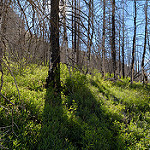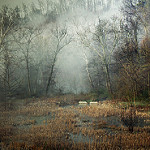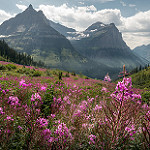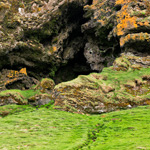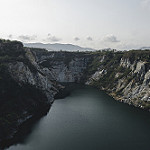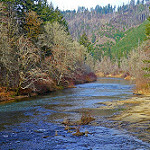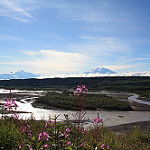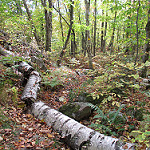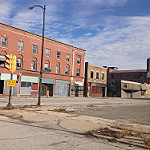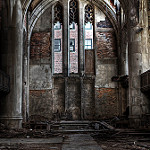Table of Contents
Territory

Beyond the Yahraw River lies the dark territory claimed by the coyote clan Inferni. Hardy trees grow anew among the fog-cloaked ruins of once-razed forests. To the east, mountains shadow the land and shelter a large cave system that serves as the clan’s den. Most distinct, however, is the coyote’s border decor: wolf skulls dangle from the trees or perch on pikes along the territory’s edge. The grim visual markers declare the coyote’s borders and serve as warning to would-be trespassers.
The Blacklands
The piece of the Blacklands Inferni has claimed still carries scars from the fire. Young trees, mostly pioneer species such as Paper Birch and White Poplar, as well as other small shrubs and weeds paint a new green across the land. However, large swaths of acidic soil and blackened stumps and logs remain, and the prey that run here tend to be small animals that can subsist on so little nutrition -- suitable, luckily, for small coyotes.
Haunted Forest
The burned ruins of the Haunted Forest are even more forlorn and ghostly. Terrible flooding reduced the center of the territory to a boggy lagoon. Around the acrid pit of water, little vegetation has sprouted even in the time since the fire; large, ashy mudflats surround the lagoon, with only the hardiest of plants growing on their outskirts. A low fog frequently clings to the earth, as it did before the forest was razed -- and it’s rumored that this fog hides spirits, the ghosts of canines who were lucky enough to survive the flames.
Ravenswrest
At the edge of the lagoon, swathed in mist, a copse of paper birch trees leans eerily over the water. This part of the old forest has fared well after the fire, and life seems drawn to it -- specifically, the ravens partnered with the coyote clan. If one is ever lost in the fog, one needs only to listen to the croaking and laughing of the black birds.
Inferni Ravens WikiDeath Mountains
Inferni lays claim to a southern section of the Death Mountains. In the lowlands and valleys, a lush young forest thrives: aspen, white birch, jack pine, and lodgepole pine have all thrived in the sunlight. At higher elevations, large tracts of land are rocky and barren, with only tough shrubs clinging to the stone.
Hellfire Hollow
Hidden in the shadow of Ashen Mountain is a vast cave system where many coyotes make their home. The main cavern is large, its ceiling 25 feet (8 meters) tall. A large quartz growth hunkers in its farthest corner. This main room branches off into several tunnels and caverns of varying sizes, where coyotes are welcome to stake their own den claims.
Enigma Lake
Lakes mark the short Enigma Peak and fill its caves. The surface of this particular lake has been bared -- it is jagged and rocky, evidence of some kind of collapse or explosion. Despite this, resilient paper birch saplings shadow the edges of the lake, and it is a popular drinking spot for coyotes and prey alike.
Phlegethon Passage
A low valley with sharp, steep cliffs on either side carves through the mountains. The streams coursing down from Enigma Peak wind their way through this passage to the ocean beyond Inferni's territory -- forming a fast, deep river. Sucking mud and sharp, unseen rocks litter the bed of the passage and threaten any coyote who attempts to cross the river to its other side, beyond the territory.
Primeval Memories
The southern river- and woodlands of Inferni are less grim than the Blacklands, though the land was certainly changed by the fire. Paper birch, white poplar, and English oak dominates the forest -- while fireweed and goldenrod paint the marshy fields pink and gold. Occasionally herds of deer and wild goats wander to the riverlands.
Yawrah River
Broad, flat floodplains expand all around the wide river, which picks up smaller creeks and streams through its long course. Its currents are lazy and mild, with little force to them -- and in some places the river slows to a crawl, dominated by the fanwort plant. Nevertheless, circling ospreys and bald eagles point to evidence of fish life beneath the surface.
Ames de la Mort
A wash of greenery, from young oak trees to flowers and other shrubs, blankets the rotted remains of trees that fell during the fire. In places the old wood resembles a colorful shrubland, but some groves provide shelter on the flat land. Mice, birds, and other small prey frequent the thickets, and even deer pass through in search of sustenance, making this excellent hunting grounds for the coyotes.
Concrete Jungle
The city did not burn as well as the surrounding forests; nevertheless, char marks and other evidence of fire can be seen clearly in the old city of Sydney. Unlike other human areas, there is very little left to scavenge from this area. Only the raw materials -- the brick and metal of the buildings -- remain. Glass windows melted or shattered from the heat, leaving the city desolate and hollowed. Even the plant life seems to avoid the center of the city; while the old suburbs have begun to show signs of sprouting to forest, downtown remains barren and lifeless.
St. Paul's Church
Located on the city's outermost edge is one of the largest churches in the city: St. Paul's Episcopal Church. Most of the church, as well as the timber houses surrounding it, were burnt out in the fires -- only the stone structure still stands. An expansive graveyard surrounds the rear of the church, with cracked and blackened gravestones standing in stony soil. The church stands alone, wide graveyard and wider fire-blasted neighborhood leveled all around it.
